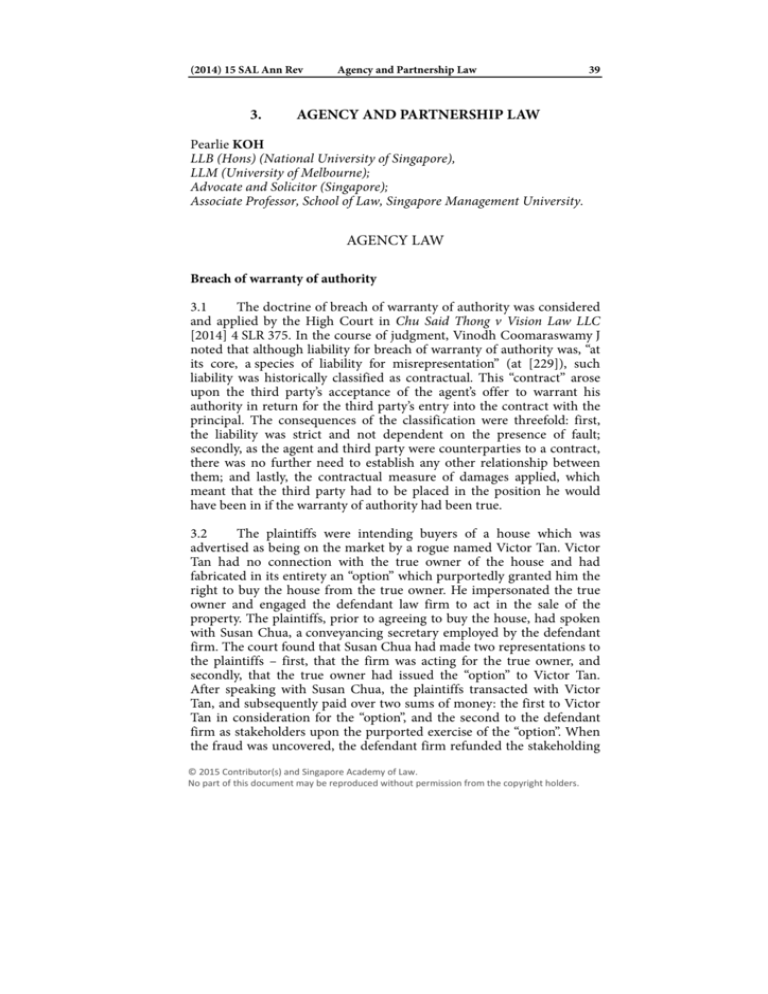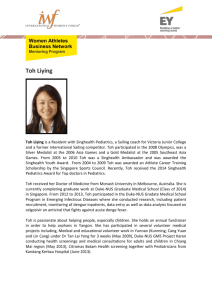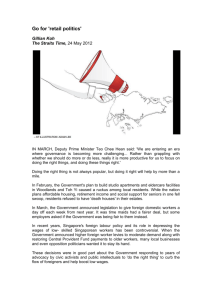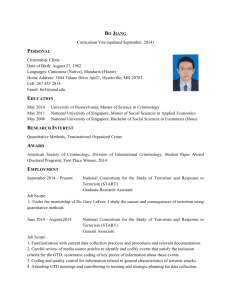View Article - Singapore Academy of Law
advertisement

(2014) 15 SAL Ann Rev 3. Agency and Partnership Law 39 AGENCY AND PARTNERSHIP LAW Pearlie KOH LLB (Hons) (National University of Singapore), LLM (University of Melbourne); Advocate and Solicitor (Singapore); Associate Professor, School of Law, Singapore Management University. AGENCY LAW Breach of warranty of authority 3.1 The doctrine of breach of warranty of authority was considered and applied by the High Court in Chu Said Thong v Vision Law LLC [2014] 4 SLR 375. In the course of judgment, Vinodh Coomaraswamy J noted that although liability for breach of warranty of authority was, “at its core, a species of liability for misrepresentation” (at [229]), such liability was historically classified as contractual. This “contract” arose upon the third party’s acceptance of the agent’s offer to warrant his authority in return for the third party’s entry into the contract with the principal. The consequences of the classification were threefold: first, the liability was strict and not dependent on the presence of fault; secondly, as the agent and third party were counterparties to a contract, there was no further need to establish any other relationship between them; and lastly, the contractual measure of damages applied, which meant that the third party had to be placed in the position he would have been in if the warranty of authority had been true. 3.2 The plaintiffs were intending buyers of a house which was advertised as being on the market by a rogue named Victor Tan. Victor Tan had no connection with the true owner of the house and had fabricated in its entirety an “option” which purportedly granted him the right to buy the house from the true owner. He impersonated the true owner and engaged the defendant law firm to act in the sale of the property. The plaintiffs, prior to agreeing to buy the house, had spoken with Susan Chua, a conveyancing secretary employed by the defendant firm. The court found that Susan Chua had made two representations to the plaintiffs – first, that the firm was acting for the true owner, and secondly, that the true owner had issued the “option” to Victor Tan. After speaking with Susan Chua, the plaintiffs transacted with Victor Tan, and subsequently paid over two sums of money: the first to Victor Tan in consideration for the “option”, and the second to the defendant firm as stakeholders upon the purported exercise of the “option”. When the fraud was uncovered, the defendant firm refunded the stakeholding © 2015 Contributor(s) and Singapore Academy of Law. No part of this document may be reproduced without permission from the copyright holders. 40 SAL Annual Review (2014) 15 SAL Ann Rev money but rejected any further liability to compensate the plaintiffs for the sum lost to Victor Tan. The plaintiffs brought the present proceedings to claim this sum, as well as further compensation for the lost opportunity to purchase a different property, on the ground, inter alia, that the defendant firm had breached its warranty of authority. 3.3 The court found that Susan Chua was, on the evidence, acting within the scope of her employment when she made the subject representations to the plaintiffs. In the circumstances, any liability for those representations was properly attributable to the defendant firm. The court also found that the representations had induced the plaintiffs to transact with Victor Tan. In this connection, the court noted (at [242]) that whether the plaintiffs had acted reasonably or not in relying on the representations did not “enter into the analysis on this cause of action” as there was ordinarily no obligation imposed on a person in the plaintiffs’ position to inquire about the putative agent’s authority or its scope and extent. The defendant firm was, therefore, held liable for breach of warranty of authority. Applying the traditional but-for test of causation and the contractual test for remoteness of damage, the court found for the plaintiffs only in respect of the sums paid to Victor Tan. In respect of the claimed sums for the lost opportunity to acquire another property, the court found that the defendant firm’s breach did not cause the loss, which was in any case too remote for recovery against the defendant firm. 3.4 The learned judge was, however, clearly concerned with overly extending the applicability of the doctrine of breach of warranty of authority, especially in the light of the developments in the law of negligent misstatement. His Honour detailed the extant difficulties with the doctrine and used the example of a hypothetical law firm approached by a new client to illustrate the anomalous nature of the doctrine. Woe betide the law firm if it should fail, despite its best efforts, to detect that its client was a fraudulent imposter, for it would potentially be liable for all loss suffered by anyone who was induced by the misrepresentation to “do virtually anything”. His Honour stated (at [269]): Liability arises … simply because of the subject matter of the misrepresentation: A[gent]’s authority to act for P[rincipal]. Looked at from the perspective of tort, and adopting the rights-based approach, the effect of the law is to endow each of us with a protected right not to be misled in any manner, however innocently, by an agent on the issue of his authority. There is no other type of information which the law considers so special that liability for a misrepresentation about that information arises without the need to establish proximity, regardless of policy considerations and without a showing of fault in order to ground recovery assessed on the contractual measure. © 2015 Contributor(s) and Singapore Academy of Law. No part of this document may be reproduced without permission from the copyright holders. (2014) 15 SAL Ann Rev Agency and Partnership Law 41 3.5 It is abundantly clear that the operation of the doctrine can be grossly unfair to the agent. However, as Tan Cheng Han pointed out in The Law of Agency (Academy Publishing, 2010) at p 256, “as between the agent and the third party, the agent is in a superior position to ascertain the existence of his authority”. Some balance therefore needs to be achieved. Nevertheless, given the developments in the modern law of torts generally, and in the area of negligent misstatement specifically, there is also much to be said for the learned judge’s call for a reconsideration of the doctrine with a view to ensuring its coherence with the modern law of obligations. PARTNERSHIP LAW Stephen BULL BA, LLB (Hons) (Wellington), LLM (Harvard); Solicitor (England and Wales), Barrister and Solicitor (New Zealand), Member of the New York Bar; Associate Professor (Practice), Singapore Management University, School of Law. Relationship of partners between themselves Admission of new partner; partnership property 3.6 The former Mitre Hotel, which once occupied a valuable plot on Killiney Road, was owned since the late 1940s by members of the Chiam family. Over that time the hotel and its site formed the epicentre of much litigation, of which the latest (and probably penultimate) episode was Chiam Heng Hsien v Chiam Heng Chow [2014] SGHC 119. From 1951 until its closure in the early 2000s, the hotel was leased to and run by a partnership, Mitre Hotel Proprietors (“MHP”). The firm was also the beneficial owner of a one-tenth undivided share in the site’s freehold; the share was registered in the name of one of the partners who had declared a trust of it in favour of “[MHP] and the partners for the time being thereof ”. The property was eventually sold in 2009 for $120m, and the present proceedings before Tay Yong Kwang J arose out of a dispute over the entitlement to MHP’s 10% share of the proceeds. The issue turned ultimately on who were the partners in the firm at the time when the land was sold. 3.7 MHP was originally established by deed in 1951, with a capital of $88,000, between four Chiam brothers – viz, Toh Say (holding a 25/88 share), Toh Moo (21/88), Toh Kai (19/88) and Toh Lew (2/88) – and their cousin, Toh Tong (21/88). The plaintiff in these proceedings was Toh Moo’s son who had become a partner in 1974 in place of his deceased father and had actually managed the hotel since then. Toh © 2015 Contributor(s) and Singapore Academy of Law. No part of this document may be reproduced without permission from the copyright holders. 42 SAL Annual Review (2014) 15 SAL Ann Rev Tong died in 1969, Toh Say in 1990, and Toh Kai in 1993. The defendants were the executors of those three original partners’ respective estates (“the defendant estates”). The other original partner, Toh Lew, died in 1975 and, under a consent judgment in 1984, his small (2/88) share was “withdrawn” in favour of the other partners. Although the court in the present proceedings held (at [69]) that Toh Lew’s share had not yet been extinguished, for reasons which were not stated, it made no practical difference to the outcome. 3.8 The plaintiff ’s case was essentially that he was the sole surviving partner and hence entitled to the entire portion of the sale proceeds attributable to MHP, some $11.5m. He denied that the defendants had been admitted as partners of MHP. He further argued that when Toh Say and Toh Kai died, their respective partnership shares had become a debt due to the relevant defendant estate (under s 43 of the Partnership Act (Cap 391, 1994 Rev Ed)) but, as no claim for such debts had been pursued, they were now time barred either under the six-year rule in s 6 of the Limitation Act (Cap 163, 1996 Rev Ed) or under the doctrine of laches. With regard to Toh Tong’s former partnership share, the plaintiff alleged that in the 1990s he had acquired it from Toh Kai, to whom it had originally passed, in consideration of the plaintiff having extended a loan to Toh Tong’s son. Under a connected arrangement with Toh Kai, the loan was in effect “secured” on that partnership share, and the latter was transferred to the plaintiff when the loan was defaulted on. Thus, apart from a nominal share which (the plaintiff conceded) Toh Kai had retained in respect of Toh Tong’s share, the plaintiff claimed that he was solely entitled to the sale proceeds. 3.9 Between them, the defendants essentially put forward four arguments in support of their entitlement to a proportionate share of the proceeds, three of which were rejected by the learned judge. First, that the declaration of trust in favour of “the partners for the time being” conferred a beneficial interest in the share of the freehold on those who were partners at the time of the declaration in 1952, that is, the original partners, so that upon their deaths the interest vested directly in the relevant defendant estate: at [70]. However the court held (at [73]), as a matter of interpretation, that the trust was in favour of those who were partners at the relevant future time, that is, the time of the sale. Secondly, it was argued that a deceased partner’s beneficial interest in land owned by a partnership was held by the surviving partners on trust for his estate, pursuant to the proviso to s 20(1) of the Partnership Act. As such, the estate had “an action to recover trust property” which was exempt from time-limitation under s 22 of the Limitation Act: at [80]. In rebutting this argument, the court pointed to the special rule under the equitable doctrine of conversion (reflected in s 22 of the Partnership Act) that partnership land is regarded, between the partners, as personal rather than real property, absent contrary agreement. This is because a © 2015 Contributor(s) and Singapore Academy of Law. No part of this document may be reproduced without permission from the copyright holders. (2014) 15 SAL Ann Rev Agency and Partnership Law 43 partner’s interest in the partnership property (including land) is not a right in specie but simply a right to a proportion of the partnership assets payable in money after discharge of the firm’s debts. Therefore, upon a technical dissolution effected by the death of a partner, his estate’s claim for his share was not one for trust property but for a debt under s 43 and so subject to the time bar: at [82]–[87]. 3.10 The defendants’ third and fourth arguments both rested on the basis that they had themselves, qua executors of the defendant estates, become partners in MHP; if so, the time bar would be rendered irrelevant. Tay J rejected the third argument, that a deceased partner’s personal representative automatically becomes a member of the firm upon the death of the partner: subject to the partnership agreement, the consent of all partners is required for admission of a partner: at [74]. Whether the defendants had become partners was therefore a question of fact. 3.11 The fourth argument was that the defendants had become partners of MHP by virtue of the plaintiff ’s agreement as implied from his conduct. There was no unequivocal direct evidence of the plaintiff ’s consent. However, the defendants argued that the plaintiff ’s claim to have become the sole partner (save for the nominal share mentioned above) was inconsistent both with the business registration records maintained by the Accounting and Corporate Regulatory Authority (“ACRA”) and with certain tax assessments levied on the defendant estates by the Inland Revenue Authority of Singapore (“IRAS”). In addition, the plaintiff ’s case against two of the defendants conflicted with positions which he had taken in affidavits given in earlier litigation touching on the partnership. 3.12 After an extensive review of the evidence, the court accepted the argument that each of the defendants had been admitted as a partner. The overall evidential picture was somewhat inconsistent and confusing. Tay J was of the view that the facts had to be approached in the light of the underlying family relations. Over the years the business had been run by the plaintiff with little formality and the defendants had not insisted on their strict legal rights. With regard to the relevance of ACRA’s partnership records under the Business Registration Act (Cap 32, 2004 Rev Ed), the court noted that their purpose was to protect the public from fraud and they were not conclusive as between the partners themselves. While a person’s registration as a partner could be evidence of such status, his Honour held that the change made after Toh Say’s death to record his estate as a partner was by itself not sufficient evidence of the estate’s admission to MHP. Of more importance was the plaintiff ’s failure to take steps to challenge such entry despite being advised to do so several times: at [92]–[95]. In relation to the tax assessments levied on the defendant estates as partners, the plaintiff had © 2015 Contributor(s) and Singapore Academy of Law. No part of this document may be reproduced without permission from the copyright holders. 44 SAL Annual Review (2014) 15 SAL Ann Rev in fact objected to IRAS’s allocation of profits which was based on the original partnership shares. However he had not protested when Toh Say’s estate paid a 25/88 share of property tax levied on the land – his silence was a factor which could be taken into account in determining whether he had implicitly accepted Toh Say’s estate as a partner: at [96]– [103]. 3.13 The court also rejected the plaintiff ’s contention that he had acquired Toh Tong’s partnership share after it first had passed beneficially to Toh Kai (see para 3.8 above). His Honour held on the evidence, firstly, that Toh Kai had not become the beneficial owner of the share (at [113]) and, secondly, that it had not formed any kind of security for the plaintiff ’s loan to Toh Tong’s son: at [122]. Thus, Toh Kai had received Toh Tong’s share qua executor of the latter’s estate, and the executorship had subsequently been transferred to the third defendant, as indeed had been accepted by the plaintiff in affidavits made by him: at [124]–[128]. 3.14 Finally, the court agreed (at [132]) that, with respect to Toh Kai’s original share, the plaintiff had accepted Toh Kai’s estate as a partner in various affidavits which he had sworn in earlier proceedings regarding the partnership. Although he had alternatively argued, based on ACRA’s records, that Toh Kai’s estate had later withdrawn from the partnership, there was evidence that this was due to a clerical error in the records. Accordingly, the fourth defendant, as executor of Toh Kai’s estate, was a partner at the time of the sale: at [134]. 3.15 In May 2015 the Court of Appeal allowed in part the plaintiff ’s appeal against the High Court’s decision: [2015] SGCA 27. The Court of Appeal’s decision, presumably the final instalment of the Mitre Hotel saga, will be noted in next year’s SAL Ann Rev. Fiduciary duties 3.16 In Guy Neale v Nine Squares Pty Ltd [2015] 1 SLR 1097, the Court of Appeal allowed an appeal from the High Court’s decision reported at [2013] SGHC 249 which was discussed in last year’s Ann Rev: (2013) 14 SAL Ann Rev 62 at 68, para 3.16. Ku De Ta was a restaurant and club in Bali owned by a partnership formed under the law of Victoria, Australia, in 2000 (“the Partnership”) and the name “Ku De Ta” was registered as an Indonesian trade mark in 2001. Subsequently, in 2004 and 2009, the respondent, a company co-owned by one of the partners named Chondros, effected registrations of the trade mark “Ku De Ta” in Singapore (“the Singapore Marks”). The other partners first learnt of the Singapore Marks in 2007. In 2009, the respondent licensed one of the Singapore Marks to a third party for a © 2015 Contributor(s) and Singapore Academy of Law. No part of this document may be reproduced without permission from the copyright holders. (2014) 15 SAL Ann Rev Agency and Partnership Law 45 new Singapore restaurant. The Partnership thereupon sued the respondent seeking a declaration that the Singapore Marks were beneficially owned by the Partnership and an account of the profits flowing from the exploitation of those marks. 3.17 The central issue was whether the Singapore Marks were held by the respondent company on trust for the Partnership: either an express trust, or a constructive trust arising from Chondros’ alleged breach of fiduciary duty in registering the Singapore Marks for his own benefit. The High Court had decided (at [134) that, although the name “Ku De Ta” generally and the associated goodwill were owned by the Partnership, the Singapore Marks were not held on either kind of trust. In reversing that decision, the Court of Appeal held that the respondent had created an express trust over the Singapore Marks. Further, the appeal court reached the view, obiter, that if Chondros had procured registration of the Singapore Marks in contemplation of a private venture to benefit himself, he would have breached his partnerial fiduciary duty, resulting in the imposition of an institutional constructive trust over those marks. (The fiduciary duty aspect of the decision is considered here; the issues of express trust and imposition of an institutional constructive trust are discussed in ch 15 at paras 15.2 and 15.16–15.17). 3.18 The alleged breach of fiduciary duty was framed principally as a usurpation of a “corporate [sic] opportunity that rightfully belonged to all members of the Partnership collectively”. The applicable test (under Victoria law) was whether Chondros (at [133]): … had taken a corporate opportunity which there was a ‘real or substantial possibility’ of the Partnership pursuing, having regard to its existing business activities and its stated aspirations. In the Court of Appeal’s view, the essential error in the High Court’s reasoning was to apply that test too narrowly. The trial court had asked whether it had been shown that the Partnership would itself have set up a “Ku De Ta”-named restaurant in Singapore at the time of the first Singapore registration, that is, 2004. The appellate court considered that the relevant opportunity included the possibility of licensing the name to a third party who might be interested in opening such a restaurant. Further, the time of registration was not, in the circumstances, the appropriate time for applying the test. The registration could be regarded as a preparatory step to the possible later exploitation of the marks (at [140]), and the evidence showed that the other members of the Partnership did contemplate such exploitation when they became aware of the registration in 2007. Had the specific licensing opportunity been brought to the Partnership’s attention at the time when the defendant’s discussions commenced with the third party in mid-2009, in © 2015 Contributor(s) and Singapore Academy of Law. No part of this document may be reproduced without permission from the copyright holders. 46 SAL Annual Review (2014) 15 SAL Ann Rev the court’s view there was a “real and substantial possibility” that the Partnership would have taken up that opportunity: at [143]. Accordingly, the Court of Appeal considered that the procurement of the Singapore registrations, if effected for Chronos’ personal benefit, would have amounted to a breach of duty by him. It followed that an institutional constructive trust could have been imposed on the Singapore Marks in favour of the Partnership. 3.19 The Court of Appeal’s analysis of the diversion of opportunity is, with respect, preferable to the lower court’s. In particular, it must be right to focus on the time of the exploitation of the opportunity and whether the remaining partners were aware of it. Otherwise, a partner might be able to secretly register for himself a name belonging to the firm so long as the actual exploitation of the name only occurred at a later time. Given that the purpose of registration is to enable exploitation of the name, that would amount to a potential conflict between the partner’s own interest and the firm’s. 3.20 In the alternative, the Partnership argued that the registration of the Singapore Marks amounted to a misappropriation of partnership property, viz, the “Ku De Ta” name, and thus a breach of Chronos’ fiduciary duty. A possible difficulty with this argument was the High Court’s finding of fact that there was no goodwill attached to the name in Singapore at the time of the registration. However, in light of their finding on usurpation of partnership opportunity, the Court of Appeal considered it unnecessary to discuss this alternative argument: at [145]. 3.21 Interestingly, no mention was made of the codified fiduciary duty in s 33 of the Victoria Partnership Act 1958 (identical to s 29 of the Singapore Partnership Act) which states that a partner is accountable “for any benefit derived by him without the consent of the other partners … from any use by him of the partnership property, name or business connection”, nor of Aas v Benham [1891] 2 Ch 244, the leading case on that section. Although the respondent company, not being a partner, was not itself bound by the section, its liability depended on there being a breach of duty by Chondros, who was so bound. In any event, it is clear that the fiduciary duties of partners continue to exist in equity alongside, and may be wider in scope than, those in the statute. 3.22 A small note of caution: in Guy Neale the issue of breach of fiduciary duty, in the context of a diversion of partnership opportunity, was governed by Victoria law, on which expert evidence was received. While the Court of Appeal did not give any indication of a divergence between Victoria and Singapore law on the point, a definitive formulation of the Singapore test must await a future case. © 2015 Contributor(s) and Singapore Academy of Law. No part of this document may be reproduced without permission from the copyright holders.








